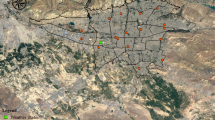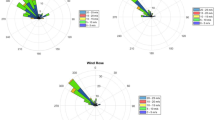Abstract
The impact of the air pollution generated by any industrial activities may be further aggravated if the location of the industrial area is exposed to certain atmospheric characteristics. Under such conditions, the likelihood of accumulation of local air pollution is high. This paper uses two approaches (statistical and numerical simulation) to investigate the contribution of atmospheric processes towards degradation of air quality. A case study of the two approaches was conducted over Sohar Industrial Area in the Sultanate of Oman. Measured wind data were used to account for specific atmospheric characteristics such as stagnation, ventilation, and recirculation using the statistical approach. In the second approach, numerical weather prediction model was used to simulate mesoscale circulation phenomena such as sea breeze and its contribution to the processes affecting the air quality. The study demonstrates that the atmospheric processes appear to contribute substantially to the degradation of air quality in the Sohar Industrial Area. The statistical analysis shows that the atmospheric dilution potential of Sohar Industrial Area is prone to stagnation and recirculation, rather than ventilation. Moreover, model simulation shows that there is a seasonal variation in the contribution of atmospheric processes to the degradation of the air quality at Sohar Industrial Area.









Similar content being viewed by others
Abbreviations
- U :
-
Observed wind speed
- θ :
-
Observed wind direction
- N :
-
Number of observations
- u i :
-
Wind vector into east–west direction of the ith observation
- v i :
-
Wind vector into north–south direction of the ith observation
- X i :
-
Transportation distance on east–west direction
- Y i :
-
Transportation distance on north–south direction
- τ :
-
Sampling intervals of the wind observation
- L i :
-
Horizontal straight line distance of the ith observation
- S i :
-
Wind run of the ith observation
- R i :
-
Recirculation factor of the ith observation
References
Al-Dabbas MA, Ayad Abbas M, Al-Khafaji RM (2010) Dust storms loads analyses—Iraq. Arab J Geosci 5(1):121–131
Allwine KJ, Whiteman CD (1994) Single-station integral measures of atmospheric stagnation, recirculation and ventilation. Atmos Environ 28(4):713–721
Bastin S, Drobinski P, Dabas A, Delville P, Reitebuch O, Werner C (2005) Impact of the Rhône and Durance valleys on sea-breeze circulation in the Marseille area. Atmos Res 74(1–4):303–328
Bornstein RD, Thompson WT (1981) Effects of frictionally retarded sea breeze and synoptic frontal passages on sulfur dioxide concentrations in New York City. J Appl Meteorol 20(8):843–858
Bouchlaghem K, Mansour FB, Elouragini S (2007) Impact of a sea breeze event on air pollution at the Eastern Tunisian Coast. Atmos Res 86(2):162–172
Charabi Y, Al-Yahyai S (2010) Integral assessment of air pollution dispersion regimes in the main industrialized and urban areas in Oman. Arab J Geosci 4(3–4):625–634
Crescenti GH (1997) Meteorological measurements during the Lower Rio Grande Valley environmental study. Environ Int 23(5):629–642
Doms G, Schattler U (2012) A description of the nonhydrostatic regional model LM. Part I: dynamics and numerics. www.cosmo-model.org. Ger Weather serv
Gangoiti G, Alonso L, Navazo M, Albizuri A, Perez-Landa G, Matabuena M, Valdenebro V, Maruri M, Antonio García J, Millán MM (2002) Regional transport of pollutants over the Bay of Biscay: analysis of an ozone episode under a blocking anticyclone in west-central Europe. Atmos Environ 36(8):1349–1361
Ghrefat HA, Howari FM (2011) Rate of deposition and quality of sedimentation dust in Al Ain and Ras Al Khaimah, United Arab Emirates. Arab J Geosci 6(4):1033–1039
Kassomenos PA, Flocas HA, Lykoudis S, Skouloudis A (1998) Spatial and temporal characteristics of the relationship between air quality status and mesoscale circulation over an urban Mediterranean basin. Sci Total Environ 217(1–2):37–57
Khelfaoui H, Chaffai H, Mudry J, Hani A (2012) Use of discriminant statistical analysis to determine the origin of an industrial pollution type in the aquiferous system of the area of Berrahal, Algeria. Arab J Geosci 6(11):4517–4527
Kim EH, Suh KS, Hwang WT, Jeong HJ, Han MH, Moon JY (2007) Analysis of the site characteristics of Korean nuclear power sites from the meteorological aspects. Ann Nucl Energy 34(9):719–723
Kwarteng AY, Dorvlo AS, Vijaya Kumar GT (2009) Analysis of a 27-year rainfall data (1977–2003) in the Sultanate of Oman. Int J Climatol 29(4):605–617
Liu H, Chan JCL (2002) An investigation of air-pollutant patterns under sea–land breezes during a severe air-pollution episode in Hong Kong. Atmos Environ 36(4):591–601
Mokadem N, Hamed Y, Sâad AB, Gargouri I (2013) Atmospheric pollution in North Africa (ecosystems–atmosphere interactions): a case study in the mining basin of El Guettar–M’Dilla (southwestern Tunisia). Arab J Geosci. doi:10.1007/s12517-013-0852-2
Moran JM, Morgan MD (1986) Meteorology: the atmosphere and the science of weather. Burgess Publishing, Incorporated
Nankar DP, Patra AK, Dole MU, Venkataraman S, Hegde AG (2009) Atmospheric stagnation, recirculation and ventilation characteristics at Kakrapar atomic power station site. Ann Nucl Energy 36(4):475–480
Sönmez I, Tekeli AE, Erdi E, Demir F, Arslan M (2013) Validation of the Meteosat Second Generation (MSG) fire monitoring product using ground observations over Turkey. Arab J Geosci. doi:10.1007/s12517-013-1039-6
Venegas LE, Mazzeo NA (1999) Atmospheric stagnation, recirculation and ventilation potential of several sites in Argentina. Atmos Res 52(1–2):43–57
Author information
Authors and Affiliations
Corresponding author
Rights and permissions
About this article
Cite this article
Al-Khadouri, A., Al-Yahyai, S. & Charabi, Y. Contribution of atmospheric processes to the degradation of air quality: case study (Sohar Industrial Area, Oman). Arab J Geosci 8, 1623–1633 (2015). https://doi.org/10.1007/s12517-014-1295-0
Received:
Accepted:
Published:
Issue Date:
DOI: https://doi.org/10.1007/s12517-014-1295-0




